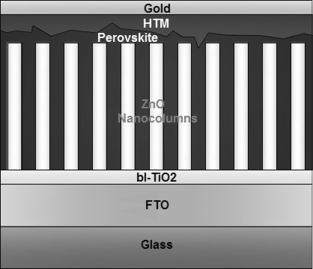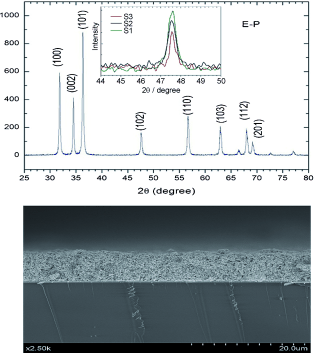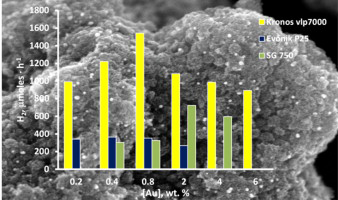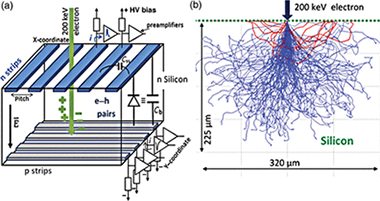Artículos SCI
2014
2014
Nanotecnología en Superficies y Plasma
Perovskite Solar Cells Based on Nanocolumnar PlasmaDeposited ZnO Thin Films
Ramos, FJ; Lopez-Santos, MC; Guillen, E; Nazeeruddin, MK; Gratzel, M; Gonzalez-Elipe, AR; Ahmad, SChemphyschem, 15 (2014) 1148-1153
Show abstract ▽

ZnO thin films having a nanocolumnar microstructure are grown by plasma-enhanced chemical vapor deposition at 423 K on pre-treated fluorine-doped tin oxide (FTO) substrates. The films consist of c-axis-oriented wurtzite ZnO nanocolumns with well-defined microstructure and crystallinity. By sensitizing CH3NH3PbI3 on these photoanodes a power conversion of 4.8 % is obtained for solid-state solar cells. Poly(triarylamine) is found to be less effective when used as the hole-transport material, compared to 2,2′,7,7′-tetrakis(N,N-di-p-methoxyphenylamine)-9,9′-spirobifluorene (spiro-OMeTAD), while the higher annealing temperature of the perovskite leads to a better infiltration in the nanocolumnar structure and an enhancement of the cell efficiency.
Abril, 2014 | DOI: 10.1002/cphc.201301215
Nanotecnología en Superficies y Plasma
Mechanisms of Electron Transport and Recombination in ZnO Nanostructures for Dye-Sensitized Solar Cells
Vega-Poot, AG; Macias-Montero, M; Idigoras, J; Borras, A; Barranco, A; Gonzalez-Elipe, AR; Lizama-Tzec, FI; Oskam, G; Anta, JAChemphyschem, 15 (2014) 1088-1097
Show abstract ▽

ZnO is an attractive material for applications in dye-sensitized solar cells and related devices. This material has excellent electron-transport properties in the bulk but its electron diffusion coefficient is much smaller in mesoporous films. In this work the electron-transport properties of two different kinds of dye-sensitized ZnO nanostructures are investigated by small-perturbation electrochemical techniques. For nanoparticulate ZnO photoanodes prepared via a wet-chemistry technique, the diffusion coefficient is found to reproduce the typical behavior predicted by the multiple-trapping and the hopping models, with an exponential increase with respect to the applied bias. In contrast, in ZnO nanostructured thin films of controlled texture and crystallinity prepared via a plasma chemical vapor deposition method, the diffusion coefficient is found to be independent of the electrochemical bias. This observation suggests a different transport mechanism not controlled by trapping and electron accumulation. In spite of the quite different transport features, the recombination kinetics, the electron-collection efficiency and the photoconversion efficiency are very similar for both kinds of photoanodes, an observation that indicates that surface properties rather than electron transport is the main efficiency-determining factor in solar cells based on ZnO nanostructured photoanodes.
Abril, 2014 | DOI: 10.1002/cphc.201301068
Materiales de Diseño para la Energía y Medioambiente
Effect of clays and metal containers in retaining Sm3+ and ZrO2+ and the process of reversibility
El Mrabet, S; Castro, MA; Hurtado, S; Orta, MM; Pazos, MC; Villa-Alfageme, M; Alba, MDAmerican Mineralogist, 99 (4) (2014) 696-703
Show abstract ▽
Knowledge and understanding about radionuclides retention processes on the materials composing the engineered barrier (clay mineral and metallic container waste) are required to ensure the safety and the long-term performance of radioactive waste disposal. Therefore, the present study focuses on the competitiveness of clay and the metallic container in the process of adsorption/desorption of the radionuclides simulators of Am3+ and UO22+. For this purpose, a comparative study of the interaction of samarium (chosen as chemical analog for trivalent americium) and zirconyl (as simulator of uranyl and tetravalent actinides) with both FEBEX bentonite and metallic container, under subcritical conditions, was carried out. The results revealed that the AISI-316L steel container, chemical composition detailed in Table 1, immobilized the high-radioactive waste (HRW), even during the corrosion process. The ZrO2+ was irreversibly adsorbed on the minireactor surface. In the case of samarium SEM/EDX analysis revealed the formation of an insoluble phase of samarium silicate on the container surface. There was no evidence of samarium diffusion through the metallic container. Samarium remained adsorbed by the container also after desorption experiment with water. Therefore, steel canister is actively involved in the HRW immobilization.
Abril, 2014 | DOI: 10.2138/am.2014.4665
Fotocatálisis Heterogénea: Aplicaciones
Production of hydrogen by water photo-splitting over commercial and synthesised Au/TiO2 catalysts
Mendez, JAO; Lopez, CR; Melian, EP; Diaz, OG; Rodriguez, JMD; Hevia, DF; Macias, MApplied Catalysis B: Environmental, 147 (2014) 439-452
Show abstract ▽

H2 production from methanol/water photo-splitting was compared using various commercial photocatalysts (Evonik P25 (P25), Hombikat UV-100 (HB) and Kronos vlp7000 (KR)) and others synthesised with a sol–gel-hydrothermal (HT) process and a sol–gel method followed by calcination (SG400 and SG750). All photocatalysts had been surface modified with Au at different concentrations, from 0.2 to 6.0 wt.%, using the photodeposition method. A complete characterisation study of the different photocatalysts was performed (BET, XRD, TEM, SEM-EDX, FTIR, UV–vis Reflectance Diffuse Spectra and aggregate size). The experiments were conducted for 3.5 h using 1 g L−1 of photocatalyst with methanol (25 vol.%) as sacrificial agent. In addition to H2 generation, production of the main intermediates, formaldehyde and formic acid, and of CO2 was also evaluated. The commercial photocatalyst KR at 0.8 wt.% Au had the highest H2 production of all the photocatalysts studied with 1542.9 μmol h−1. Of the photocatalysts synthesised by our group, SG750 at Au loading of 2.0 wt.% gave the highest H2 production of 723.1 μmol h−1. The SG750 photocatalyst at Au loading of 2.0 wt.% also had the highest H2 production yield per unit of surface area at 45.5 μmol g h−1 m−2.
Abril, 2014 | DOI: 10.1016/j.apcatb.2013.09.029
Materiales Nanoestructurados y Microestructura
Detecting single-electron events in TEM using low-cost electronics and a silicon strip sensor
Gontard, LC; Moldovan, G; Carmona-Galn, R; Lin, C; Kirkland, AIMicroscopy, 63(2) (2014) 119-130
Show abstract ▽

There is great interest in developing novel position-sensitive direct detectors for transmission electron microscopy (TEM) that do not rely in the conversion of electrons into photons. Direct imaging improves contrast and efficiency and allows the operation of the microscope at lower energies and at lower doses without loss in resolution, which is especially important for studying soft materials and biological samples. We investigate the feasibility of employing a silicon strip detector as an imaging detector for TEM. This device, routinely used in high-energy particle physics, can detect small variations in electric current associated with the impact of a single charged particle. The main advantages of using this type of sensor for direct imaging in TEM are its intrinsic radiation hardness and large detection area. Here, we detail design, simulation, fabrication and tests in a TEM of the front-end electronics developed using low-cost discrete components and discuss the limitations and applications of this technology for TEM.
Abril, 2014 | DOI: 10.1093/jmicro/dft051
- ‹ anterior
- 278 of 420
- siguiente ›














